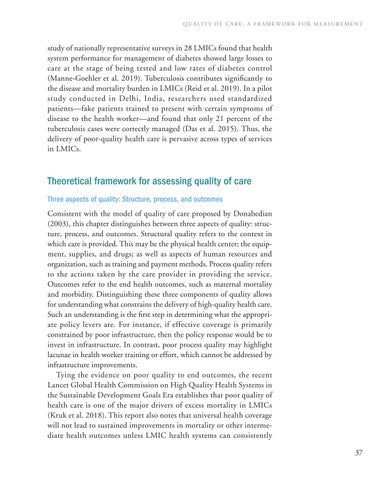QUALITY OF CARE: A FRAMEWORK FOR MEASUREMENT
study of nationally representative surveys in 28 LMICs found that health system performance for management of diabetes showed large losses to care at the stage of being tested and low rates of diabetes control (Manne-Goehler et al. 2019). Tuberculosis contributes significantly to the disease and mortality burden in LMICs (Reid et al. 2019). In a pilot study conducted in Delhi, India, researchers used standardized patients—fake patients trained to present with certain symptoms of disease to the health worker—and found that only 21 percent of the tuberculosis cases were correctly managed (Das et al. 2015). Thus, the delivery of poor-quality health care is pervasive across types of services in LMICs.
Theoretical framework for assessing quality of care Three aspects of quality: Structure, process, and outcomes Consistent with the model of quality of care proposed by Donabedian (2003), this chapter distinguishes between three aspects of quality: structure, process, and outcomes. Structural quality refers to the context in which care is provided. This may be the physical health center; the equipment, supplies, and drugs; as well as aspects of human resources and organization, such as training and payment methods. Process quality refers to the actions taken by the care provider in providing the service. Outcomes refer to the end health outcomes, such as maternal mortality and morbidity. Distinguishing these three components of quality allows for understanding what constrains the delivery of high-quality health care. Such an understanding is the first step in determining what the appropriate policy levers are. For instance, if effective coverage is primarily constrained by poor infrastructure, then the policy response would be to invest in infrastructure. In contrast, poor process quality may highlight lacunae in health worker training or effort, which cannot be addressed by infrastructure improvements. Tying the evidence on poor quality to end outcomes, the recent Lancet Global Health Commission on High Quality Health Systems in the Sustainable Development Goals Era establishes that poor quality of health care is one of the major drivers of excess mortality in LMICs (Kruk et al. 2018). This report also notes that universal health coverage will not lead to sustained improvements in mortality or other intermediate health outcomes unless LMIC health systems can consistently 37

